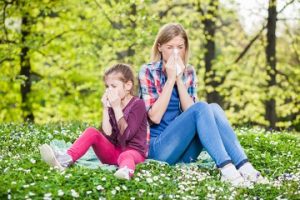March 08, 2018 | Black & Kletz Allergy

Birch, oak, cedar, elm, ash, cottonwood, hickory, and maple are the predominant trees producing pollen in our area. It is the reproductive season for the trees and the pollen grains are released into the atmosphere to fertilize the ovules of other trees. Pollen is produced and dispersed by the wind throughout the day, but their counts are highest in the morning hours.
Over the past several years, many researchers have noted a progressive increase in the tree pollen counts across the country. Though it is somewhat controversial, many scientists believe that climate change is contributing to this trend at least in part. Carbon dioxide is the principal gas needed for the growth and development of trees, (along with nutrients, water, and sunlight), and increasing levels of carbon dioxide are being documented every year. Changes in the climate may impact pollen seasons of trees, grasses, and weeds by both increasing the amount of pollen produced as well as by extending the duration of the pollen season.
Pollen grains are not toxic or harmful when inhaled, unless the person’s immune system mistakes them as potentially dangerous and mounts a defensive attack on them. This process, called allergic sensitization and reactivity, results in the release of certain chemicals such as histamine, which are mediators of the bothersome symptoms of allergic rhinitis (i.e., hay fever) and allergic conjunctivitis.
The most common symptoms of Spring allergies may include itchy eyes, red eyes, watery eyes, puffy eyes, sneezing, clear nasal secretions, nasal congestion, post-nasal drip that may cause throat irritation and cough, itchy throat, clogged ears, sinus pressure, sinus headaches, and/or snoring. In asthmatics, the pollen can also trigger wheezing, chest tightness, coughing, and/or shortness of breath.
Spring allergies are diagnosed by board certified allergists by first taking a comprehensive history and physical examination. Allergy testing is often done by either skin testing or occasionally by blood testing in order to identify the offending allergen. Once identified, preventive measures are recommended in order to reduce exposure to the allergen(s).
Measures to reduce exposure to pollen and to minimize symptoms include the following:
- Follow the local pollen counts on the homepage on our website by clicking Today’s Pollen Count and avoid outdoor activities on high pollen days, especially in early morning hours.
- Run errands shortly after it rains, as the water keeps the pollen closer to the ground and keeps it from blowing around.
- After being outdoors, change clothes and wash the ones that were worn outside.
- Leave shoes outside so you do not bring the pollen into the home.
- Wipe down the fur of the pet or wash the pet before the animal comes indoors.
- Shower before going to bed in order to wash the pollen off one’s hair and skin.
- Close the windows in homes and automobiles and run the air conditioning if needed.
- Begin taking antihistamines and nasal sprays early in the season. They are more effective if begun before the onset of severe symptoms and if taken daily throughout the season. There are a variety of other types of prescription medications that may be utilized by the allergist in order to mitigate unwanted allergy and/or asthma symptoms in sensitive individuals.
- In cases of persistent or severe symptoms, consider allergy desensitization (i.e. allergy shots, allergy immunotherapy, allergy injections, allergy hyposensitization) to the pollen, which can provide a long-term benefit and reduce the need for medications. They are effective in 80-85% of patients.
Does local honey help?
There is no scientific evidence to substantiate the claim that consuming local honey will help either to desensitize to pollen or to reduce symptoms.
The board certified allergy doctors at Black & Kletz Allergy has 3 locations in the Washington, Northern Virginia, and Maryland metropolitan area. We have offices in Washington, DC, McLean, VA (Tysons Corner, VA), and Manassas, VA. All 3 of our offices have on-site parking and the Washington, DC and McLean, VA offices are Metro accessible. The McLean office has a complementary shuttle that runs between our office and the Spring Hill metro station on the silver line. The allergists of Black & Kletz Allergy diagnose and treat both pediatric and adult patients. For an appointment, please call our office or alternatively, you can click Request an Appointment and we will respond within 24 hours by the next business day. The allergy specialists at Black & Kletz Allergy have been helping patients with hay fever, asthma, sinus disease, eczema, hives, insect sting allergies, immunological disorders, medication allergies, and food allergies for more than 50 years. If you suffer from allergies, it is our mission to improve your quality of life by reducing or preventing your unwanted and aggravating allergy symptoms.












